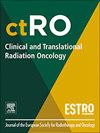Prediction for cardiac and pulmonary toxicity in a multicentric cohort of advanced stage NSCLC patients using sub-regions of the heart
IF 2.7
3区 医学
Q3 ONCOLOGY
引用次数: 0
Abstract
Purpose
Follow-up investigations in locally advanced stage non-small cell lung cancer (NSCLC) patients treated with radiochemotherapy (RCHT) regularly focus around lung toxicity. However, Cardiac Adverse Events (CAE) can occur much earlier in patients than originally anticipated with serious repercussions for patient quality-of-life and survival.
Therefore, here we investigated spatial dependencies of dose within the heart and their correlation with toxicity, with dosimetric parameters of sub-regions of the heart at the focus of this analysis.
Additionally, we aimed to explore the connection between cardiac toxicity and pulmonary toxicity.
Methods
Patient treatment plans with dosimetric data for the lungs and the heart, as well as toxicity data for 502 NSCLC patients treated with either passively scattered proton therapy (PSPT), intensity modulated radiation therapy (IMRT), three-dimensional conformal radiation therapy (3DCRT) or volumetric arc therapy (VMAT) with or without chemotherapy was retrospectively retrieved from prospective clinical studies of three international centers. Cardiac toxicity data was not available for all patients. Data was randomly split into a training set (336) and validation set (166). Statistical analyses were performed using binomial logistic regression.
Results
In univariate modeling, the Mean Lung Dose (MLD) significantly predicted CAE grade ≥ 3 in the training-set (pMLD = 0.02, AUCtrain = 0.69), which was confirmed in validation (AUCval, = 0.77). No suitable candidates for the construction of multivariate models could be identified. Parameters of the heart and its subregions did not significantly predict CAE grade ≥ 3 in the investigated cohorts. No parameters were found to significantly predict CAE grade ≥ 2 or RP. Finally, no spatial dependency was found in the investigated toxicity data.
Conclusion
The pulmonary dosimetric parameter MLD successfully predicted CAE grade ≥ 3 in a cohort treated with either photons or protons. Cardiac dosimetric parameters as well as spatial parameters did not perform similarly. No parameters were found to significantly predict RP in the investigated cohorts.
利用心脏亚区域预测晚期 NSCLC 患者多中心队列的心肺毒性
目的 对接受放射化学疗法(RCHT)治疗的局部晚期非小细胞肺癌(NSCLC)患者进行的随访调查通常以肺部毒性为重点。因此,我们在此研究了心脏内剂量的空间依赖性及其与毒性的相关性,并将心脏亚区域的剂量参数作为分析的重点,此外,我们还旨在探索心脏毒性与肺毒性之间的联系。方法回顾性地从三个国际中心的前瞻性临床研究中检索了502例NSCLC患者的治疗计划,其中包括肺部和心脏的剂量数据,以及接受或不接受化疗的被动散射质子疗法(PSPT)、调强放射疗法(IMRT)、三维适形放射疗法(3DCRT)或容积弧形疗法(VMAT)治疗的患者的毒性数据。并非所有患者都有心脏毒性数据。数据随机分为训练集(336)和验证集(166)。结果在单变量建模中,训练集的平均肺剂量(MLD)能显著预测 CAE 分级≥3(pMLD = 0.02,AUCtrain = 0.69),这在验证集中得到证实(AUCval, = 0.77)。没有发现适合构建多元模型的候选者。在所调查的队列中,心脏及其亚区域的参数并不能显著预测 CAE 等级≥ 3。没有发现任何参数能明显预测 CAE 等级≥ 2 或 RP。结论在接受光子或质子治疗的人群中,肺剂量学参数 MLD 可成功预测 CAE 等级≥3。心脏剂量学参数和空间参数的表现不尽相同。在所调查的队列中,没有发现任何参数能明显预测 RP。
本文章由计算机程序翻译,如有差异,请以英文原文为准。
求助全文
约1分钟内获得全文
求助全文
来源期刊

Clinical and Translational Radiation Oncology
Medicine-Radiology, Nuclear Medicine and Imaging
CiteScore
5.30
自引率
3.20%
发文量
114
审稿时长
40 days
 求助内容:
求助内容: 应助结果提醒方式:
应助结果提醒方式:


